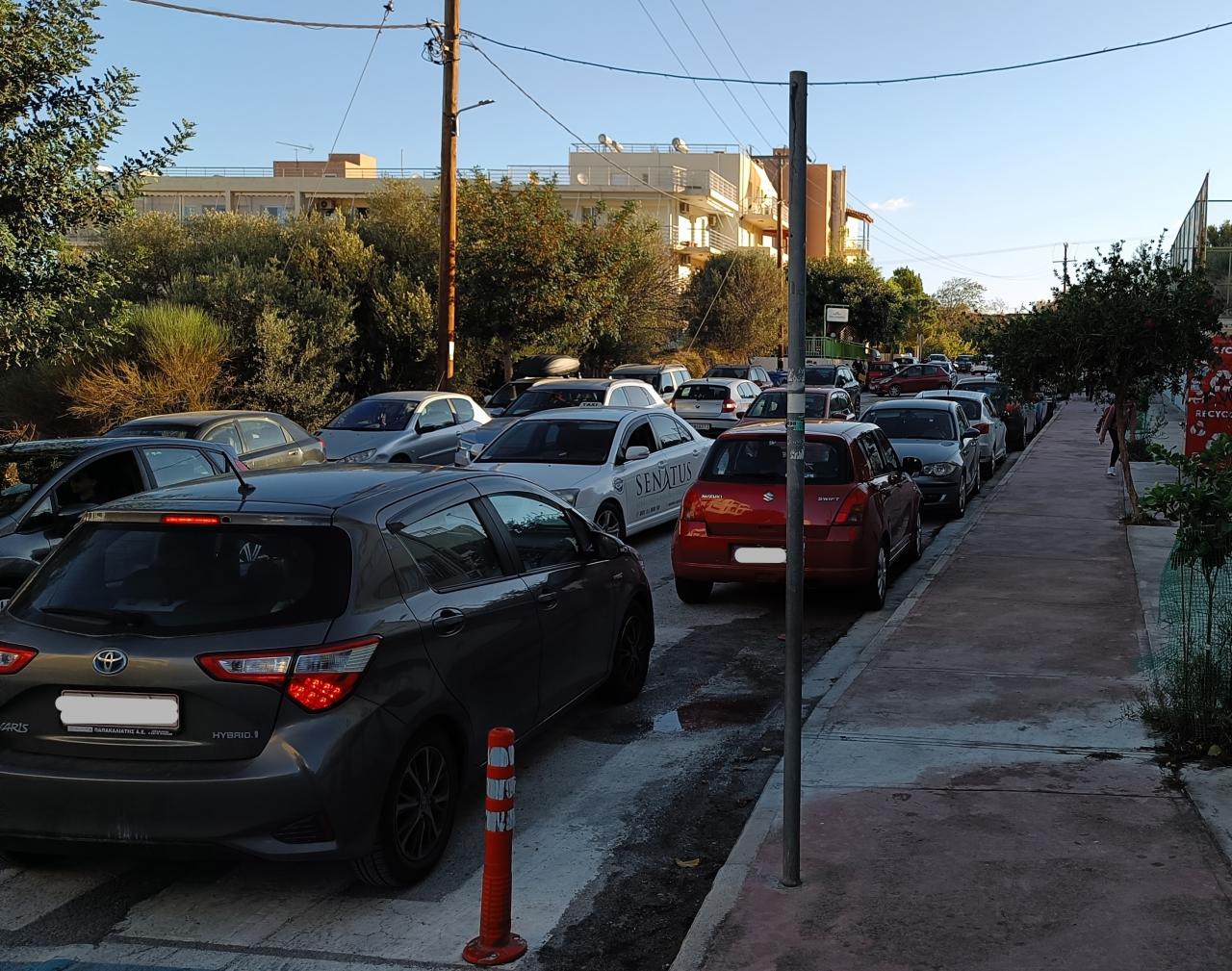The answer to this short and simple question is YES. At least it was a YES when the SCHOOLHOODs team met at the URBACT Summer University in August 2023 and performed a problem tree analysis to identify the main challenge underlying the network’s policy challenge. Which is on the question “why do so many children get driven to school by car” despite the known negative consequences related to school trips performed by parents driving their kids to school.
Taking a closer look at the challenge, the problem of more and more children getting driven to school by car quickly got more complex. But let’s take a step back and see what these negative consequences and the underlying dynamics that led to this situation are. Concerning the effects of school trips by car, the story is quickly told: driving our children to school by car adds more cars to the classical traffic peaks in the morning, at the time, when the transport network is at its capacity limits anyways. It adds to the problem of air and noise pollution, which is specifically critical, since the transport sector is the only sector that fails reducing greenhouse gas emissions. But even more significant, school trips by car increase the challenge of too little physical activity of children and youth. Which in turn hampers our children’s healthy development in terms of physical, cognitive, and social competences.
These effects, especially the negative prospect to our children’s healthy development, should alert us to change the way we act. But this is not the case. And it gets even more questionable why we do not act and change the way our children “go” to school when reflecting on how today’s parent’s generation got to school themselves. We did a simple survey at local stakeholder meetings of all our network cities asking, “how did you go to school when you were a pupil”? The overwhelming majority answered, “I walked” or “I used public transport”. Only in very few cases the answer was “by car”, and there were reasonable motives behind like for security reasons (not to be mistaken for safety reasons like traffic is too dangerous). We, as today’s parent generation, do not reflect on our own experience as pupils but take different modal choices for our children’s school trips. At least to a certain extent. Our main concern was then to find out about the “whys”. Since obviously something changed in between the time of parent’s own childhood and today. The question is “what are the underlying dynamics that led to today’s challenge of school trips by car?”.
Digging deeper during our self-analysis of our 8 network cities as well as more global trends, we identified four dynamics:
Urban development and urban sprawl
Urban development of the last decades detached the figure of land-take and population development. New developments were low-density ones increasing the distances people have to cover for their daily needs. In addition, the city development followed the model of separated functional districts instead of mixed-use areas which further increased travel distances.
Increased motorisation rates
Urban development favoured trips by car to allow covering the longer distances in the given travel time budget (which is a constant of 1-1,5 hours per day that does not change). Cars became affordable at the same time. Together, urban structures, transport networks and the affordability of cars resulted in a sharp increase of car ownership since the 1960’s in the western EU Member States and accelerating with the fall of communism regimes in the “new” EU Member States.
The rise of the car culture
With the increasing role of cars for moving in our cities, cars themselves got fashionable and became a status symbol. Car ownership got detached from the mere role of a transport mode and became a way to express our “way of life”, being tied to personal values or emotional attachment. The development of car culture was driven by car industry commercial activities but as well by the entertainment industry producing movies, broadcastings and stories tying people emotionally to cars. In addition, car ownership takes a significant role to showcase economic prosperity, especially in the countries former under communist rule.
Social convenience
These three factors determine a highly relevant further dynamic: it became comfortable to use the car, it became a habit. Both, our interviews in our network cities as well as research results highlight that comfort and convenience form a major motivation for parents to take their children to school by car. Road safety concerns, that are often mentioned as a reason for the choice of cars, are given as a reason, but do largely not form the main motivation. Road safety certainly is a challenge, but it is mostly visible directly in front of schools at school start (and partially at lessons’ end) out of the parents arriving at the school by car and creating a traffic mayhem for 30 minutes.
These major dynamics are visible in all our SCHOOLHOODs network cities. But the analyses in each city add specific local challenges:
The role of the teachers: the common point is that teachers and headmasters are decisive to take influence on school trips. But interest and attitude of both vary from city to city and range from taking a supportive role, to being indifferent, to supporting car centric schemes.
The role of neighbours to the school: neighbours, like residents and businesses, might welcome traffic calming measures or see them as a potential threat to limit their own mobility options.
The interest of pupils in walking or cycling to school: Many of our cities report a strong interest of pupils to walk or cycle to school, but some cities know that pupils are reluctant to walk or cycle and prefer to be driven by car. Cycling abilities of pupils forms a problem itself as well.
The role of school locations: in some cities, school locations hamper the accessibility by walking or cycling from traffic or terrain specifics. In other cities, school locations concentrate in the centre multiplying traffic capacity problems by the number of schools in the area.
The topography of the cities: general conditions for walking and cycling are highly different ranging from flat and dense city structures to disperse and hilly settlements structures.
The provision of transport services and infrastructure: the level of public transport service ranges from an excellent European champion to very limited public transport availability with long intervals and only little operating hours. The same range applies to the provision of walking and cycling infrastructures in the network cities.
How is the answer on “is it all about the parents” now?
Taking a look at this question, the answer needs to be changed from YES to PARTIALLY. The problem is more complex and has to include more stakeholders than parents, needs to work with the provision of transport services as alternatives to private car use and has to review the infrastructure conditions around schools and within the transport network to schools.
In short, our work is with PEOPLE, TRAFFIC, and INFRASTRUCTURE. Consequently, we address all 3 topic fields:
For our work with PEOPLE, we invest in better understanding the motivations of parents for their modal choice to create fitting motivational activities to arrive at a behaviour change in the end. We will combine the transport world with motivators from other professions like health, economics, economics, sports, and psychology. We will include teachers and headmasters but also neighbours of the school neighbourhood in this to motivate them to become role-models and supporters to our work on safe, green, and happy trips to school.
For our work with TRAFFIC, we explore options on changing road space use cases like heart zones, school streets, superblocks without tackling infrastructure changes. And investigate how to employ services solutions like walking buses, cycling buses, ride sharing, drop-off zones, school bus schemes, public transport layout and services, regulating traffic and enforcing traffic rules.
For our work with INFRASTRUCTURE, we address improving transport networks for active mobility (walking, cycling and scooter use), maintenance of this infrastructure throughout the year, provision of parking facilities for bikes and scooters, attractive public transport stops and traffic calming by infrastructure interventions. We will combine learning with the aspect of financing structural changes and piloting these to safeguard that they work as intended.
SCHOOLHOODS used these activity descriptions for people, traffic and infrastructure to design its learning and exchange programme for the coming two years. We are confident to learn from each other using e.g. master classes, site visits, peer reviews and deep dives. But we recognise the need as well to involve external expertise to enrich our approach and ability. Such as for using gamification to address all three topic fields. Or for preparing and running a behaviour change process beyond the pure discipline knowledge on modal choices.
We look forward to our challenging but highly triggering work and invite you to follow our progress. The first chance is to take a look at our self-analysis, its results and the detailed activities derived from that once our Baseline Study is published start of the coming year.
Stay tuned and follow us on the SCHOOLDHOODS section on the URBACT website!


